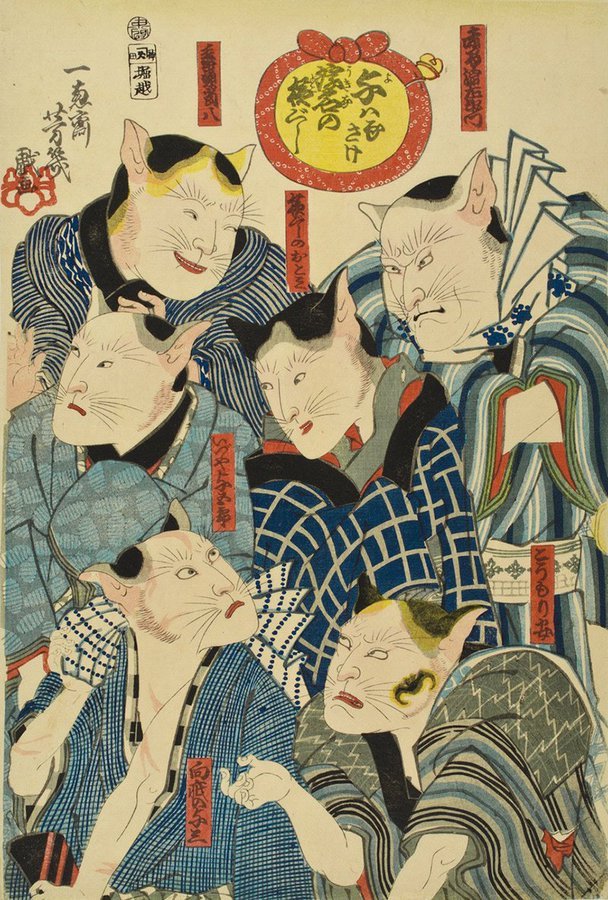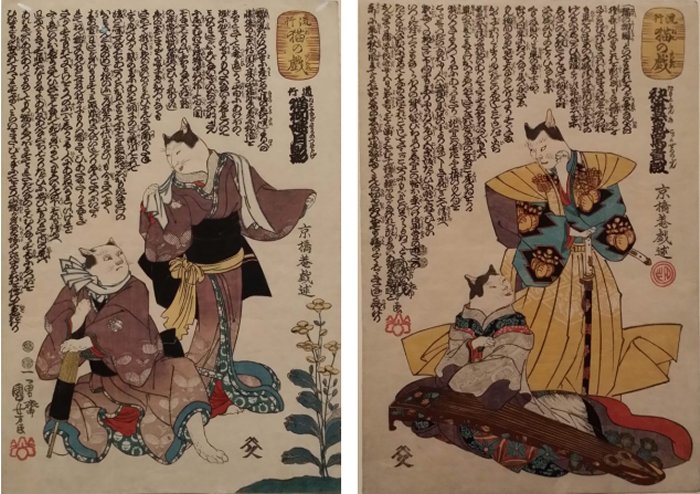Why Were Actors Painted As Cats By Ukiyo-e Artists In Japan?
Conny Waters - AncientPages.com - If you enjoy art, you may have stumbled upon older Japanese paintings portraying people as cats. It may look funny and cute, but it's not always a subject of pure humoristic entertainment but rather restrictions and censorship.
Painting from 1860 from The Story of Otomi and Yosaburo' by Utagawa Yoshiiku. Credit: Public Domain
If you go to Japan, you can find many places where images of cats suddenly appear. In modern Japan, there are cat cafes, shrines, temples, a cat train station master, and a cat island. Cat Day is celebrated on February 22. Japan does cat worship better than any country on Earth.
Cats are said to have arrived in Japan about 1,000 years ago. Cats traveling onboard ships carrying Buddhist scriptures from China to Japan entered not only the country but the heart of the Japanese people.
Cats were considered guardians of Buddhist scriptures, but they were also troublemakers. Their mischievous deeds, such as stealing food or destroying things, have been the subject of many Japanese folktales. The cat's mysterious nature led to the creation of the Bakeneko, or "cat monster," which is a legendary yokai in Japanese mythology.
Stories of the supernatural legends of Bakeneko can be found in many Japanese folktales. The most famous account is the tale of the Nabeshima Bakeneko Disturbance in Saga Prefecture.
Many Japanese artists loved cats, which is one reason cats are found in paintings, prints, and sculptures.
Left: The Scene of Torture by Scolding from the play The Stinky Sleeve from the series Fashionable Cat Frolics. Print by Utagawa Kuniyoshi. - Right: Cats Performing in the Michiyuki Scene in the play Neko yanagi sakari no tsukikage from the series Fashionable Cat Frolics. Print by Utagawa Kuniyoshi. Credit: Yatta-Tachi
The great Japanese ukiyo-e master Utagawa Kuniyoshi (1798 – 1861) is famous for his love of cats, and these lovely felines kept him company in his studio.
Ukiyo-e (literally meaning "Pictures of the Floating World") is a Japanese art that emerged during the Edo period (1603 – 1868) when Japan focused on culture instead of wars.
Ukiyo-e artists produced paintings and woodblock prints depicting everyday life and people's interests. The word ukiyo refers to the world of ordinary people, and e means "picture."
Thanks to advances in woodblock printing techniques, Ukiyo-e art became an appreciated art form in Japan's popular culture. Many Ukiyo-e prints and paintings depict Kabuki actors, sumo wrestlers, and beautiful women, but scenes from history and folk tales, including travel scenes landscapes, and erotica, are also popular.
In the mid-19th century, the faces of Kabuki actors were suddenly replaced with cat faces. The government banned pictures of actors and courtesans, considering them detrimental to public morals.
Artists had to find a way to work around the limitations of censorship, and they successfully produced great paintings and prints giving the actors the look of cats, but enough of their features were left in place. It allowed Kabuki fans to recognize the actor even though he appeared like a cat.
Updated on April 20, 2024
Written by Conny Waters – AncientPages.com Staff Writer
Copyright © AncientPages.com All rights reserved. This material may not be published, broadcast, rewritten or redistributed in whole or part without the express written permission of AncientPages.com
Expand for referencesHarkins, William E. "Japanese Animal Prints" Impressions, no. 15 (1989). Accessed February 11, 2020.
Linda Lombardi - Cats In Japanese Art - Printed, Painted and Sculpted Felines
Cindy Caraturo - Life of Cats: Selections from the Hiraki Ukiyo-e Collection
More From Ancient Pages
-
 Great Sakya Library Is Home To 84,000 Scrolls Left Untouched For Hundreds Of Years
Featured Stories | Jul 22, 2021
Great Sakya Library Is Home To 84,000 Scrolls Left Untouched For Hundreds Of Years
Featured Stories | Jul 22, 2021 -
 Scientists Unravel Why Humans Used Tiny Flakes 300,000 Years Ago
Archaeology | Dec 15, 2022
Scientists Unravel Why Humans Used Tiny Flakes 300,000 Years Ago
Archaeology | Dec 15, 2022 -
 Daily Life Of Télpochcalli Students Of The Aztec Empire Was A Challenge
Ancient History Facts | Apr 20, 2020
Daily Life Of Télpochcalli Students Of The Aztec Empire Was A Challenge
Ancient History Facts | Apr 20, 2020 -
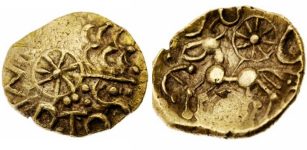 Ancient Coin Reveals Name Of Unknown British Iron Age King – Who Was ‘Esunertos’?
Archaeology | Oct 21, 2023
Ancient Coin Reveals Name Of Unknown British Iron Age King – Who Was ‘Esunertos’?
Archaeology | Oct 21, 2023 -
 Florida’s Windover Bog Bodies Predate The Egyptian Pyramids And Can Rewrite Ancient American History
Featured Stories | Jun 3, 2021
Florida’s Windover Bog Bodies Predate The Egyptian Pyramids And Can Rewrite Ancient American History
Featured Stories | Jun 3, 2021 -
 Legend Of Milky Way’s Celestial Portal And The Star City From The Bowuzhi By Zhang Hua
Featured Stories | Feb 14, 2024
Legend Of Milky Way’s Celestial Portal And The Star City From The Bowuzhi By Zhang Hua
Featured Stories | Feb 14, 2024 -
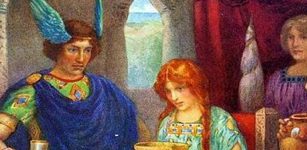 Skirnir’s Mission To Jotunheim To Gain Gerda For Lovesick God Frey
Featured Stories | Mar 14, 2020
Skirnir’s Mission To Jotunheim To Gain Gerda For Lovesick God Frey
Featured Stories | Mar 14, 2020 -
 5000-Year-Old Cold Case: Neolithic Fisherman Died By Drowning – Forensic Study Shows
Archaeology | Feb 14, 2022
5000-Year-Old Cold Case: Neolithic Fisherman Died By Drowning – Forensic Study Shows
Archaeology | Feb 14, 2022 -
 3,800-Year-Old Wall Relief Created By Ancient Caral People Unearthed In Peru
Archaeology | Aug 28, 2018
3,800-Year-Old Wall Relief Created By Ancient Caral People Unearthed In Peru
Archaeology | Aug 28, 2018 -
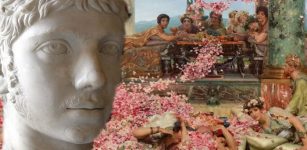 Museum Classifies Roman Emperor Elagabalus As Trans – But Modern Labels Oversimplify Ancient Gender Identities
Featured Stories | Nov 28, 2023
Museum Classifies Roman Emperor Elagabalus As Trans – But Modern Labels Oversimplify Ancient Gender Identities
Featured Stories | Nov 28, 2023 -
 Neanderthal And Denisovan Blood Groups Deciphered And The Results Are Surprising
Archaeology | Aug 2, 2021
Neanderthal And Denisovan Blood Groups Deciphered And The Results Are Surprising
Archaeology | Aug 2, 2021 -
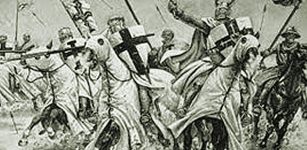 On This Day In History: Battle Of The Rhyndacus – Oct 15, 1211
News | Oct 15, 2015
On This Day In History: Battle Of The Rhyndacus – Oct 15, 1211
News | Oct 15, 2015 -
 On This Day In History: Naval Battle Of Rennell Island Fought Off Guadalcanal – On Jan 29, 1943
News | Jan 29, 2017
On This Day In History: Naval Battle Of Rennell Island Fought Off Guadalcanal – On Jan 29, 1943
News | Jan 29, 2017 -
 Kofun: Megalithic Keyhole-Shaped Tombs That Belonged To High Status People In Japan
Civilizations | Oct 31, 2018
Kofun: Megalithic Keyhole-Shaped Tombs That Belonged To High Status People In Japan
Civilizations | Oct 31, 2018 -
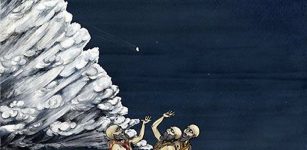 Controversial 5,500-Year-Old Sumerian Star Map Of Ancient Nineveh Reveals Observation Of Köfels’ Impact Event
Artifacts | Dec 28, 2018
Controversial 5,500-Year-Old Sumerian Star Map Of Ancient Nineveh Reveals Observation Of Köfels’ Impact Event
Artifacts | Dec 28, 2018 -
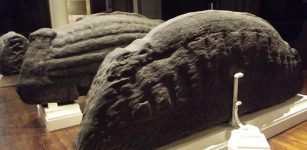 The Govan Stones – Treasures From The Viking Era In Britain
Featured Stories | Dec 27, 2015
The Govan Stones – Treasures From The Viking Era In Britain
Featured Stories | Dec 27, 2015 -
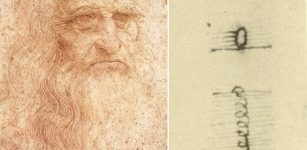 Leonardo da Vinci’s Paradox Cracked
Ancient Technology | Jan 19, 2023
Leonardo da Vinci’s Paradox Cracked
Ancient Technology | Jan 19, 2023 -
 Mysterious Clay Tablet Reveals Babylonians Used Trigonometry 1,000 Years Before Pythagoras
Archaeology | Aug 24, 2017
Mysterious Clay Tablet Reveals Babylonians Used Trigonometry 1,000 Years Before Pythagoras
Archaeology | Aug 24, 2017 -
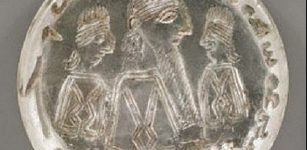 Mani: Apostle Of Light And His Ancient Rock Crystal Seal
Featured Stories | Jul 2, 2018
Mani: Apostle Of Light And His Ancient Rock Crystal Seal
Featured Stories | Jul 2, 2018 -
 This Is The Mysterious Hilltop Where Civilization Began Scientists Say
Archaeology | Jun 24, 2022
This Is The Mysterious Hilltop Where Civilization Began Scientists Say
Archaeology | Jun 24, 2022

